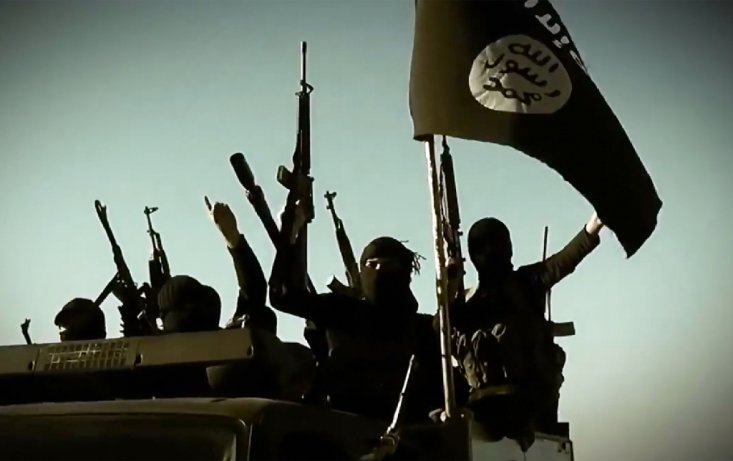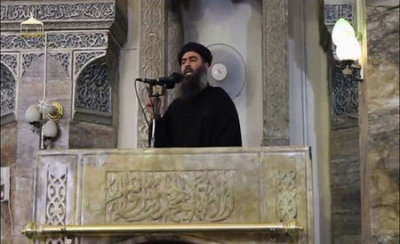ISIL could pose threat to US, Europe, officials say
The group is now considered “the most potent military force” of any terrorist outfit in the world

An image grab taken from a propaganda video released on March 17, 2014 by the Islamic State of Iraq and the Levant …
U.S. counterterrorism officials have dramatically ramped up their warnings about the threat posed by the Islamic State of Iraq and the Levant (ISIL), concluding that the well-armed group is expanding its ambitions outside the Middle East and may be planning terror attacks against western Europe — and even the U.S. homeland.ISIL’s conquest of vast swaths of Iraqi territory this spring and summer netted it a “significant” arsenal of U.S. weapons from two Iraqi military bases, including hundreds of tanks, heavily armored Humvees, assault rifles, and rocket-propelled grenade launchers, officials say. One U.S official tells Yahoo News ISIL is now considered “the most potent military force” of any terrorist group in the world.
Led by its charismatic chief Abu Bakr al-Baghdadi, the radical Islamist group is looking beyond its short-term goal of overthrowing the Iraqi and Syrian governments and replacing them with a self-proclaimed Islamic Caliphate. “We’re seeing an expansion of its external terrorist ambitions,” one U.S. counterterrorism official said in a briefing for reporters Thursday. “As its capabilities grow, it has attracted thousands of foreign extremists — some of whom are going home to start cells. As it carves out territory [in Iraq], it wants to go beyond that and do attacks outside. ” U.S. counterterrorism agencies had put the number of ISIL fighters at about 10,000, but that figure is now being reassessed and is likely to be raised, officials say.
Just four years ago the group, then calling itself the Islamic State of Iraq, was scattered and on the run from American forces, aided by Sunni tribes horrified by the group’s often grotesque violence. Its reign has been marked by summary executions, ritual stonings, beheadings and even crucifixions.
What fueled its resurgence? Officials say the group fed off Sunni resentment over the Shia-dominated government of Iraq’s Prime Minister Nouri al-Maliki, who announced his resignation Thursday night. It took advantage of the power vacuum in northern Iraq to seize large chunks of essentially ungoverned territory. It saw an opportunity in recruiting prisoners; in July 2013, its suicide bombers blew their way into the notorious Abu Ghraib prison, freeing up to 500 inmates, including al-Qaida leaders.

A man purported to be the reclusive leader of the militant Islamic State Abu Bakr al-Baghdadi from a video recording …
These demonstrable successes gave the group new credibility among jihadis around the world, especially after it joined the civil war in Syria and changed its name to ISIL. (It has at times also been known as ISIS, or the Islamic State of Iraq and Syria.) It has since changed its name again to the Islamic State after proclaiming itself a caliphate, the latest in a succession of Muslim empires dating back to the seventh century. Its ranks were soon swelled by foreigners, including hundreds of followers of the red-bearded Chechen militant Omar al-Shishani, a former Georgian army sergeant known for his deep hatred of America.
Concerns about terrorism spilling over from Syria and Iraq hit home in June when French police arrested an “armed jihadi” who had just returned from Syria in connection with the May 24 killing of four people — including two Israeli tourists — at a Jewish Center in Brussels.
Since then, authorities in Europe have broken up terror cells linked to ISIL, including one in Kosovo where officials this week arrested 40 suspects who had returned from Iraq and Syria—including some who had fought with ISIL — and seized weapons and explosives in dozens of locations.
ISIL and its followers have also proven adept at using social media, making a steady barrage of threats against the West, including the United States.
“Probably most striking are the threats on Twitter,” said a U.S. official who monitors the postings. “We’ve seen tens of thousands of postings by ten of thousands of people supporting ISIL, making threats to blow up U.S. Embassies.” One posting showed an ISIL banner apparently superimposed on an image of the White House.
It is still unclear how real those threats are, at least while ISIL is focused on its war with the Iraqi government. And the resignation of the deeply unpopular Maliki could allow for more U.S.-Iraqi cooperation in the fight against the insurgents.
But increasingly, officials say, ISIL has the perception of momentum. For the first time there are signs that some jihadis linked to al-Qaida are expressing sympathy, if not allegiance, to ISIL — despite al-Qaida chief Ayman al-Zawahri’s disavowal of the group.
One thing ISIL does not lack is funds. The group has seized banks, accumulating vast amounts of cash and raking in more by selling oil and other commodities to smugglers. ISIL “is flush with cash. It has plenty of money. They control oil fields, they have refiners. They have hundreds of millions of dollars,” said one U.S. analyst at the Thursday briefing.
And it is exceptionally well armed. When ISIL forces assaulted two Iraqi military bases, Camp Speicher and Rasheed Air Base, in July, they got the keys to the kingdom — hundreds of millions of dollars’ worth of American tanks, armored personal carriers, howitzers and other equipment. ISIL fighters have posed for videos brandishing MANPADS, shoulder-launched surface to air missiles that can shoot down low-flying aircraft..

This undated file image posted on a militant website on Tuesday, Jan. 14, 2014, which has been verified and is …
“They’ve got enough supplies, equipment and ammunition to last them five years,” said John Maguire, a former top CIA officer in Iraq who retains close ties to the Kurdish regional government. Thanks in part to assistance from former Iraqi military officers who have defected to ISIL, “they know how to operate American equipment.”
What they also have, at least for the moment, is a de facto safe haven. Al-Baghdadi — who officials say sees himself as the true successor to Osama bin Laden — is believed to be constantly on the move. But ISIL appears to have established a headquarters in Raqqa in northern Syria, where the group’s black banners reportedly fly over administrative buildings.
Given that President Obama has placed sharp limits on U.S. airstrikes and confined them to Iraq, that effectively makes Baghdadi and his top deputies — almost all of whom were once in U.S. custody — off-limits to U.S. military action. The Raqqa safe haven “is a problem,” acknowledged one U.S. official.
The bottom line, U.S. counterterrorism officials say, is that new strategies are urgently needed to counter the surging ISIL threat. In the briefing for reporters Thursday, one senior official made the point in the most understated way possible: “We don’t assess at the moment this [the threat from ISIL] is something that will collapse on its own.”
